Tengo un niño de 5 años, como madre y docente trato de hacer herramientas que le ayuden en su aprendizaje en casa, el conoce todos los números del 0 al 9 y actualmente el sabe contar hasta el 100 de forma progresiva, solo equivocándose en algunos números, pero aun tiene problemas para reconocer algunos numero de dos cifras de manera aleatoria, por otro lado ya comienza a realizar operaciones matemáticas como suma y resta de sencillas, quise hacer estos números para ayudarle a mejorar , porque cada niño aprende a su ritmo y el muestra mucho entusiasmo por los números.
I have a 5-year-old boy, as a mother and teacher I try to make tools that help him in his learning at home, he knows all the numbers from 0 to 9 and currently he knows how to count up to 100 progressively, only making mistakes in some numbers , but he still has problems to recognize some numbers of two figures in a random way, on the other hand he already begins to perform mathematical operations such as addition and subtraction of simple ones, I wanted to do these numbers to help him improve, because each child learns at his own pace and the shows a lot of enthusiasm for numbers.
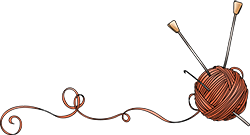
Consideraciones sobre el estilo de aprendizaje / Learning style considerations
Hay que tener en cuenta que no todos las personas tienen el mismo estilo de aprendizaje, algunos somos visuales, otros auditivos y otros (en menor número) son kinestesicos, es decir que para algunos es más fácil aprender cuando observan, otros cuando escuchan y otros cuando tocan o involucran su cuerpo y su motricidad fina y gruesa (las manos o las piernas). Por otro lado, estos estilos de aprendizaje no son tan fáciles de detectar cuando los niños son muy pequeños, pero a veces es ventajoso saberlos, mi hijo ha mostrado habilidades en los tres estilos de aprendizaje , es decir, que no podría definir exactamente de qué tipo es, por lo que he observado es muy visual y auditivo, pero también me he dado cuenta que le gusta mucho involucrarse, es decir, el quiere agarrar las cosas, tocarlas y tiene mucha energía física, no le gusta mucho estar siempre en un mismo sitio. Por eso pensé que hacerle unos números que el pidiera manipular con sus manos sería una herramienta de aprendizaje muy buena.
It must be borne in mind that not all people have the same learning style, some of us are visual, others auditory and others (to a lesser number) are kinesthetic, that is, for some it is easier to learn when they observe, others when they listen and others when they touch or involve your body and your fine and gross motor skills (hands or legs). On the other hand, these learning styles are not so easy to detect when children are very young, but sometimes it is advantageous to know them, my son has shown skills in all three learning styles, that is, he could not define exactly what type is, from what I have observed he is very visual and auditory, but I have also realized that he likes to get involved a lot, that is, he wants to hold things, touch them and has a lot of physical energy, he does not like to always be in a same place. That is why I thought that making him some numbers that he asked to manipulate with his hands would be a very good learning tool.

¿Por qué números tejidos? / Why woven numbers?
Además de ser mi técnica favorita de las manualidades, estos números en crochet son ideales para los niños, si los números se ensucian se pueden lavar, al mismo tiempo no los puede romper ni rayar como ocurriría con números de cartón o foami, por poseer textura generada por los puntos a crochet, suavidad generada por el relleno y vistosidad por los colores, creo que es una opción ideal para captar la atención de un niño con tanta energía como mi hijo.
In addition to being my favorite technique of crafts, these crochet numbers are ideal for children, if the numbers get dirty they can be washed, at the same time you cannot tear or scratch them as it would happen with cardboard or foami numbers, because they have texture generated by the crochet stitches, softness generated by the filling and showiness by the colors, I think it is an ideal option to capture the attention of a child with as much energy as my son.

¿Cuántos números hacer? / How many numbers to make?
La elección va a depender de la edad del niño, pero si yo hacía solo los números del 0 al 9 mi hijo no podría hacer las secuencias combinatorias completas hasta el 100 porque necesitaba tener cifras de números dobles como por ejemplo 11, 22, 33 …. Por ello decidí hacer dos números de cada uno, es decir veinte, para que con estos números pudiera formar completa la secuencia de números de dos cifras y en gran parte la secuencia numérica de tres cifras siempre que no se repita un mismo numero tres veces. Por ahora para su nivel de aprendizaje, hasta el 100 está bien.
The choice will depend on the age of the child, but if I only made the numbers from 0 to 9 my son would not be able to do the complete combinatorial sequences up to 100 because he needed to have double numbers such as 11, 22, 33 ... . That is why I decided to make two numbers of each, that is, twenty, so that with these numbers I could complete the sequence of two-digit numbers and to a large extent the three-digit numerical sequence as long as the same number is not repeated three times. For now for his level of learning, up to 100 is fine.

¿Cómo jugar? / How to play?
Realicé el símbolo + y el símbolo – con estos mi hijo ya esta sumando y restando cifras pequeñas, obviamente se comienza contando con los dedos de sus manos y el escoge el número correcto. También jugamos a contar de manera progresiva y regresiva, igualmente jugamos a escoger un numero, yo le digo un numero de dos cifras y el debe buscar los números y colocarlos en el orden correcto. Como los números son de colores y hay pares por cada uno, también juega a ordenarlos según color y forma, es decir que está trabajando con ambos hemisferios cerebrales. Siempre es necesario recordar que para un niño jugar es aprender.
I made the symbol + and the symbol - with these my son is already adding and subtracting small figures, obviously he starts counting with the fingers of his hands and he chooses the correct number. We also play counting progressively and backwards, we also play to choose a number, I tell him a two-digit number and he must look for the numbers and place them in the correct order. As the numbers are colored and there are pairs for each one, he also plays to order them according to color and shape, that is, he is working with both cerebral hemispheres. It is always necessary to remember that for a child to play is to learn.

Materiales / Materials
- Materiales / Materials
- Hilo de colores variados (yo escogí colores del arcoíris)
- Ganchillo # 4 (1.25mm)
- Relleno de fibra sintética antialérgica (o cualquier relleno)
- Aguja de ojal grande
- Patrón
- Yarn to knit in assorted colors (I chose rainbow colors)
- Crochet # 4 (1.25mm)
- Antiallergic synthetic fiber padding (or any padding)
- Large buttonhole needle
- Pattern

Proceso / Process
El primer paso es hacer los patrones o gráficos de los números, yo les comparto los patrones en imágenes pero si los quieres replicar usen hojas de papel milimetrado y un lápiz. Los gráficos son muy fáciles de leer, cada cuadro representa un punto de tejido, entonces lo gráficos pueden leerse de arriba abajo o viceversa. Comenzando con cadenas y tejiendo sobre estas los puntos iniciales, los aumentos y disminuciones siempre se hacen a los lados derecho o izquierdo según corresponda el patrón, cuando existan puntos adicionales se hacen tejiendo cadenas y sobre estas tejiendo los puntos correspondientes. Algunos números pueden hacerse por partes y coserlos y también hay números que requiere levantar puntos. Les explico el proceso de cada uno.
The first step is to make the patterns or graphs of the numbers, I share the patterns in images but if you want to replicate them use sheets of graph paper and a pencil. The graphs are very easy to read, each frame represents a knitting stitch, so the graphs can be read from top to bottom or vice versa. Starting with chains and knitting the initial stitches over these, the increases and decreases are always made on the right or left sides as the pattern corresponds, when there are additional stitches they are made by knitting chains and on these knitting the corresponding stitches. Some numbers can be made in parts and sewn together and there are also numbers that require lifting stitches. I explain the process of each one.

Número 1 / Number 1
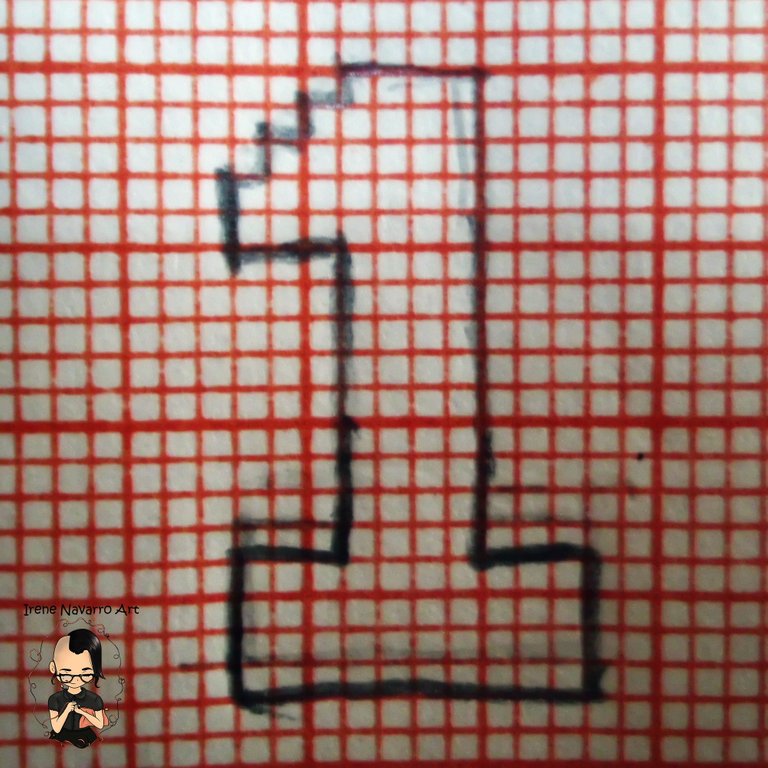
En este numero seguir el patrón de abajo hacia arriba, es decir, tejer 10 cadenas, sobre ellas tejí 10 puntos bajos por cuatro rondas, luego levante 4 puntos en el centro y tejer 9 rondas, en la última ronda tejer 3 cadenas, para luego regresar y tejer sobre ellas tres puntos y los siguientes 4 puntos, hacer 1 disminución de un lado por tres rondas. Tejer otro igual y lo unír al primero tejiendo puntos bajos por todo alrededor, rellenando de fibra antes de cerrar.
In this number follow the pattern from bottom to top, that is, knit 10 chains, on them I knit 10 single crochets for four rounds, then pick up 4 stitches in the center and knit 9 rounds, in the last round knit 3 chains, and then go back and knit three stitches over them and the next 4 stitches, make 1 decrease on one side for three rounds. Knit another the same and join it to the first by knitting single crochets all around, filling with fiber before closing.
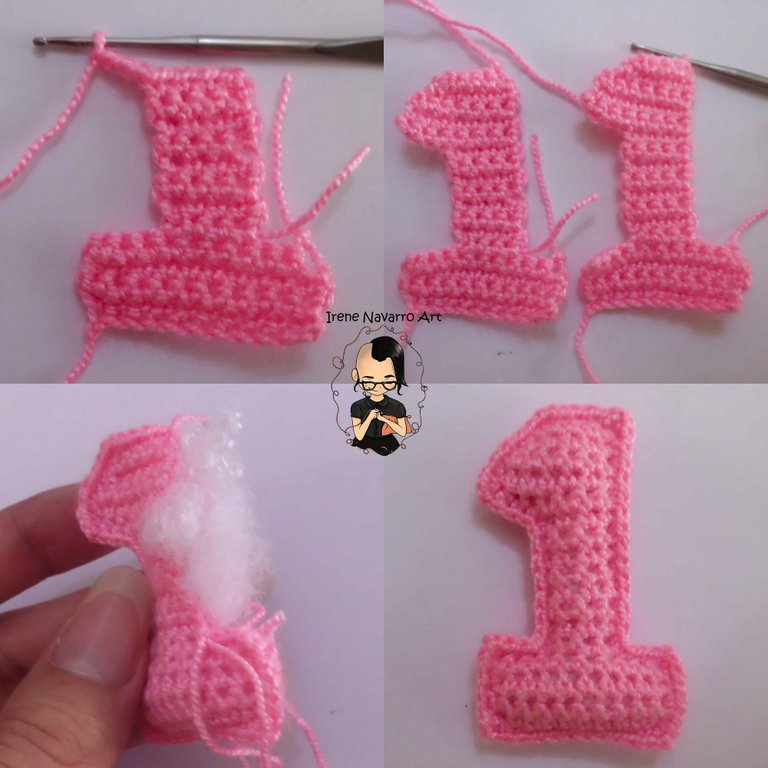

Número 2 / Number 2
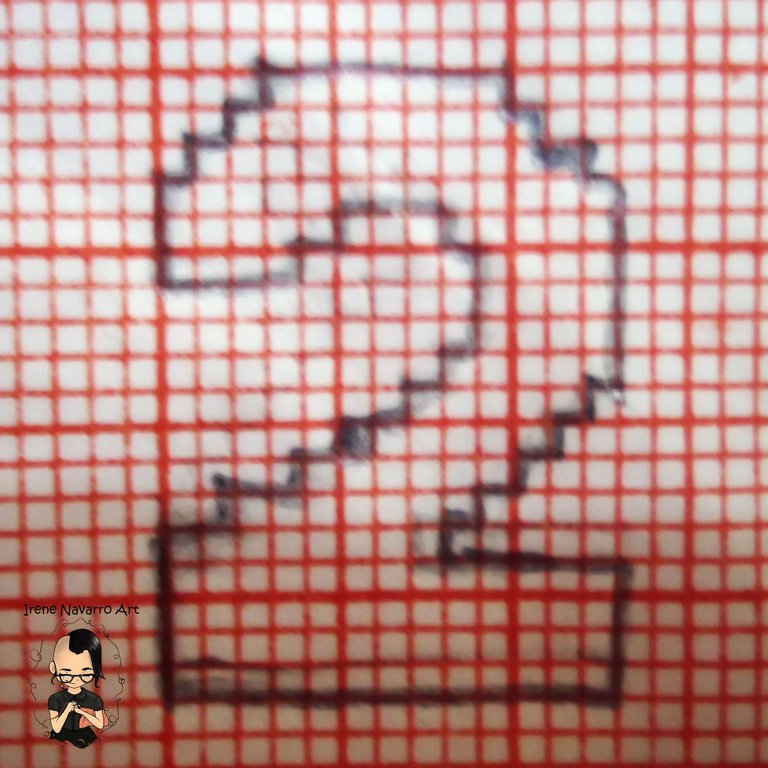
Seguir el patrón de abajo hacia arriba, tejer 13 cadenas, sobre estas tejer cuatro rondas de puntos bajos, en la quinta tejer solo 8 puntos bajos, siguiendo el patrón hacer aumentos al inicio y disminuciones al final de cada ronda o viceversa según corresponda hasta llegar a la ronda catorce es la primera parte.
Luego para la segunda leer el grafico de arriba hacia abajo. Tejer 7 cadenas y sobre estas tejer 7 puntos bajos, luego hacer aumentos al inicio y al final por tres rondas hasta obtener 13 puntadas, en la quinta ronda tejer solo 5 puntos bajos y regrese a la sexta ronda tejiendo una disminución y tres puntos bajos. Luego unir ambas partes cosiéndolas con la aguja de ojal grande. Hacer otro número igual y unir al primero tejiendo puntos bajos por todo alrededor, rellenando de fibra antes de cerrar.
Follow the pattern from bottom to top, knit 13 chains, on these knit four rounds of single crochets, on the fifth knit only 8 single crochets, following the pattern make increases at the beginning and decreases at the end of each round or vice versa as appropriate until reaching to the fourteenth round is the first part.
Then for the second read the graph from top to bottom. Knit 7 chains and on these knit 7 single crochets, then make increases at the beginning and at the end for three rounds until you get 13 stitches, in the fifth round knit only 5 single crochets and return to the sixth round knitting a decrease and three single crochets. Then join both parts by sewing them with the large buttonhole needle. Make another equal number and join the first by knitting single crochets all around, filling with fiber before closing.
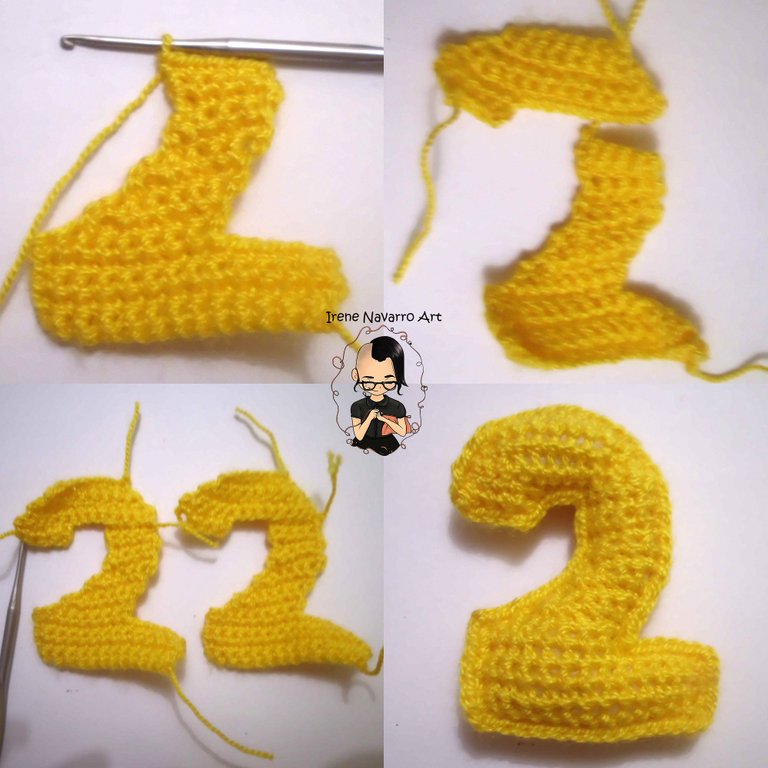

Número 3 / Number 3
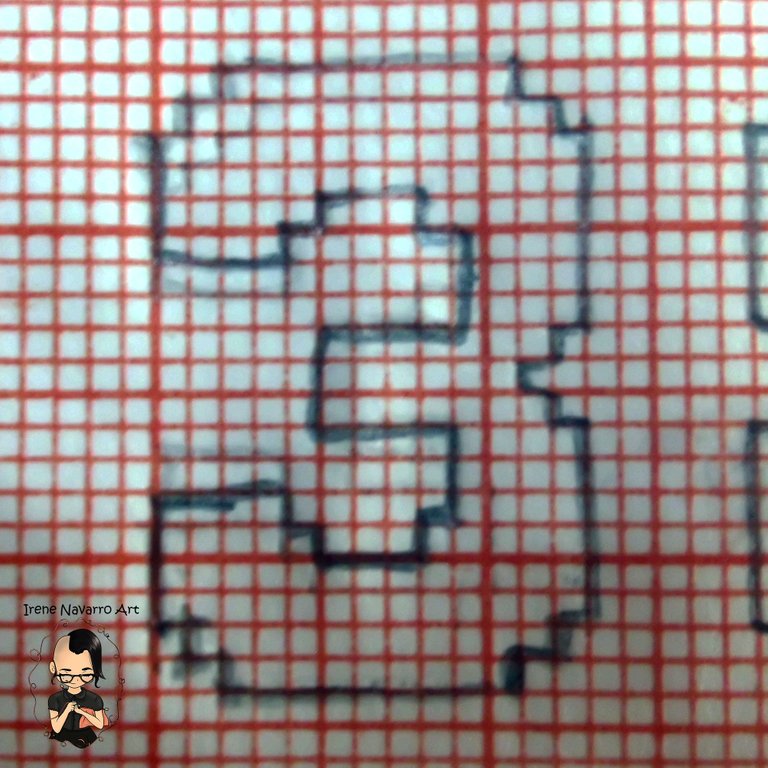
Tejer 9 cadenas para iniciar y tejer 9 puntos bajos sobre estas, hacer aumentos a cada lado por dos rondas hasta obtener 13 puntadas, tejer una ronda sin aumentos, en la siguiente tejer solo 5 puntos bajos y regresar para tejer 1 disminución y 3 puntos bajos.
Para la segunda parte levantar 5 puntos bajos en el otro extremo, en la siguiente ronda tejer 3 puntos bajos y una diminución, tejer dos rondas sin aumentos en esa última ronda tejer 4 cadenas adicionales para tejer sobre ellas en la ronda siguiente 6 puntos bajos y una disminución, la siguiente ronda tejer 1 disminución y 5 puntos bajos, en la siguiente tejer 5 puntos bajos y un aumento. Tejer 1 aumento y dos puntos bajos, tejer dos rondas sin aumentos, luego tejer 1 aumento y tres puntos bajos.
Tejer la tercera parte exactamente igual a la primera y unirlas cosiendo con una aguja de ojal grande. Hacer otro número igual y unir al primero tejiendo puntos bajos por todo alrededor, rellenando de fibra antes de cerrar.
Knit 9 chains to start and knit 9 single crochets over them, make increases on each side for two rounds until you get 13 stitches, knit one round without increases, in the next knit only 5 single crochets and return to knit 1 decrease and 3 single crochets .
For the second part, lift 5 single crochets at the other end, in the next round knit 3 single crochets and a decrease, work two rounds without increases in that last round, knit 4 additional chains to knit over them in the next round 6 single crochets and a decrease, the next round knit 1 decrease and 5 single crochets, in the next round knit 5 single crochets and an increase. Work 1 increase and two single crochets, work two rounds without increases, then work 1 increase and three single crochets.
Knit the third part exactly the same as the first and join them by sewing with a large buttonhole needle. Make another equal number and join the first by knitting single crochets all around, filling with fiber before closing.


Número 4 / Number 4
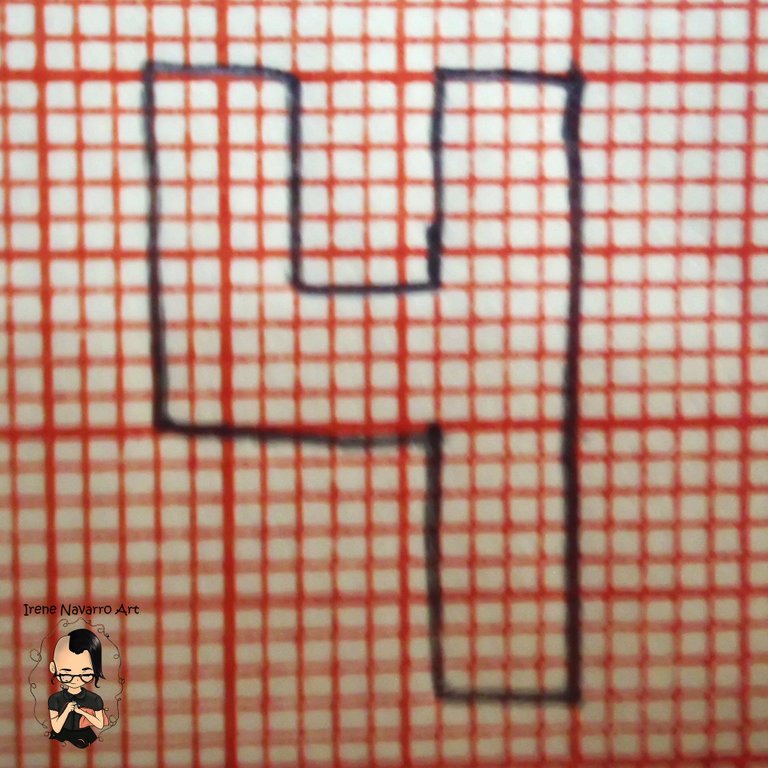
Tejer 4 cadenas y sobre estas tejer ocho rondas de puntos bajos, en la última ronda tejer 8 cadenas adicionales para tejer sobre estar 12 puntos bajos por cuatro rondas, tejer solo 4 puntos bajos por seis rondas. Levantar 4 puntos bajos en el otro extremo y tejer seis rondas. Hacer otro número igual y unir al primero tejiendo puntos bajos por todo alrededor, rellenando de fibra antes de cerrar.
Knit 4 chains and on these knit eight rounds of single crochets, in the last round knit 8 additional chains to knit over 12 single crochets for four rounds, work only 4 single crochets for six rounds. Pick up 4 single crochets at the other end and work six rounds. Make another equal number and join the first by knitting single crochets all around, filling with fiber before closing.
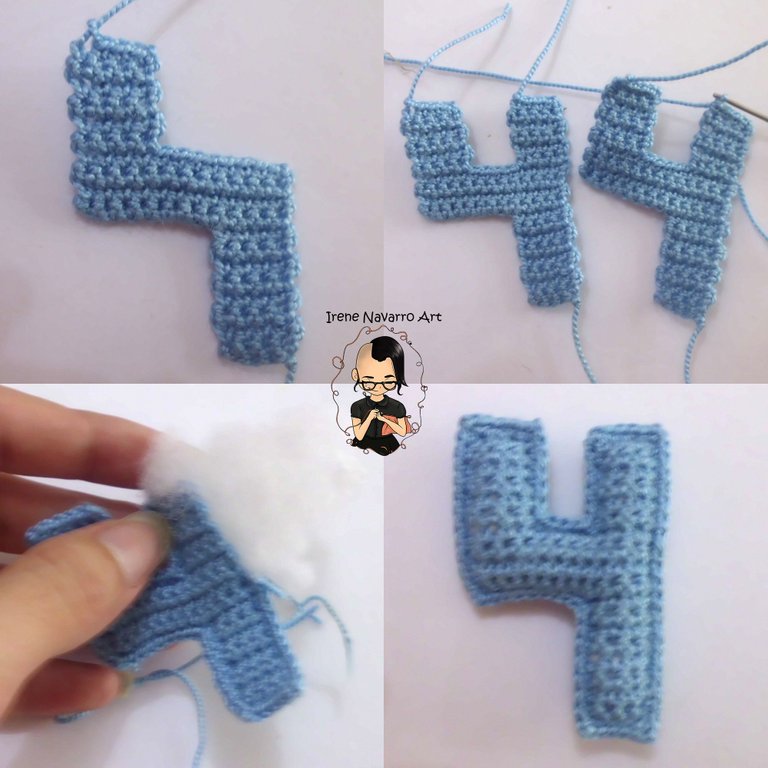

Número 5 / Number 5
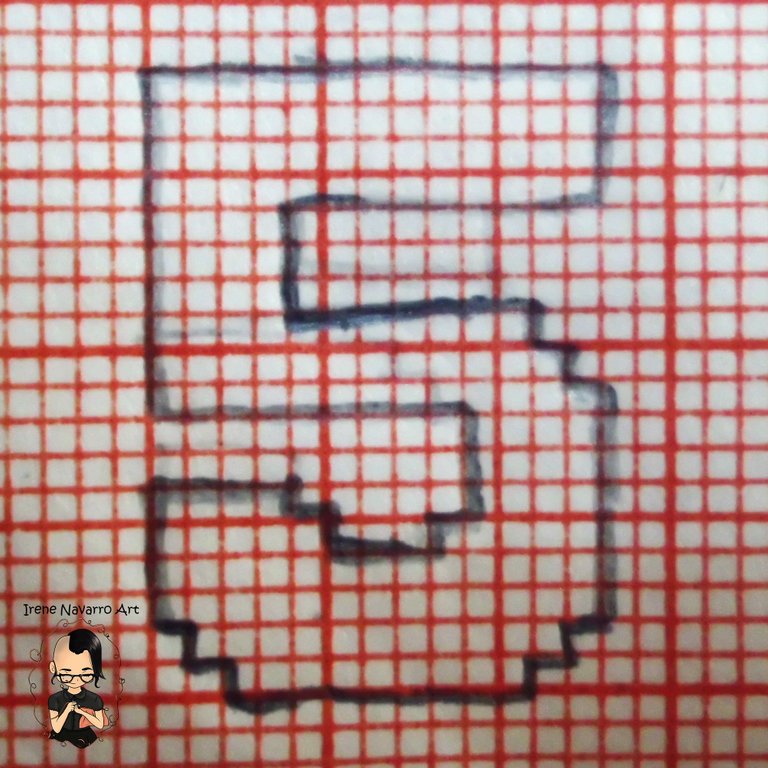
Comenzar de arriba hacia abajo, tejiendo 13 cadenas y sobre estas tejer 13 puntos bajos por cuatro rondas. Tejer solo 4 puntos bajos por tres rondas, en la última ronda tejer 7 cadenas adicionales para tejer sobre estas 11 puntos bajos. Tejer 10 puntos bajos y 1 aumento. Tejer 1 aumento y 11 puntos bajos.
Para la segunda parte, leer el patrón de abajo hacia arriba, tejer 9 cadenas para iniciar y tejer 9 puntos bajos sobre estas, hacer aumentos a cada lado por dos rondas hasta obtener 13 puntadas, tejer una ronda sin aumentos, en la siguiente tejer solo 5 puntos bajos y regresar para tejer 1 disminución y 3 puntos bajos. Levantar 5 puntos bajos en el otro extremo, en la siguiente ronda tejer 3 puntos bajos y una diminución, tejer dos rondas sin aumentos. Unir las dos partes cosiendo con una aguja de ojal grande. Hacer otro número igual y unir al primero tejiendo puntos bajos por todo alrededor, rellenando de fibra antes de cerrar.
Start from top to bottom, working 13 chains and over these work 13 single crochets for four rounds. Knit only 4 single crochets for three rounds, in the last round knit 7 additional chains to knit over these 11 single crochets. Work 10 single crochets and 1 increase. Work 1 increase and 11 single crochets.
For the second part, read the pattern from bottom to top, knit 9 chains to start and knit 9 single crochets over them, make increases on each side for two rounds until you get 13 stitches, knit one round without increases, on the next single knit 5 single crochets and return to work 1 decrease and 3 single crochets. Pick up 5 single crochets at the other end, in the next round knit 3 single crochets and a decrease, knit two rounds without increases. Join the two parts by sewing with a large buttonhole needle. Make another equal number and join the first by knitting single crochets all around, filling with fiber before closing.
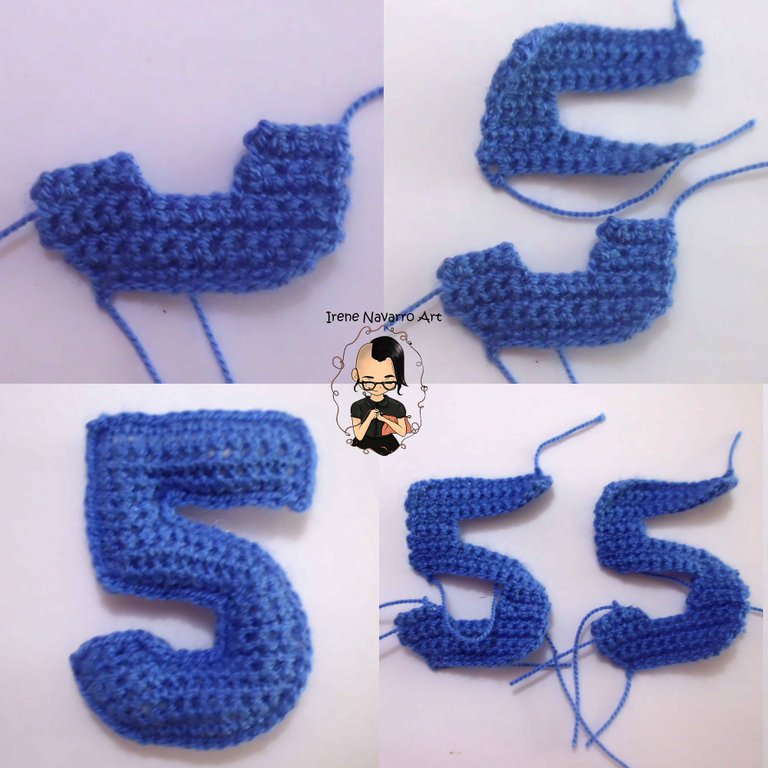

Número 6 / Number 6

Leer el grafico de abajo hacia arriba, tejer 9 cadenas para iniciar y tejer 9 puntos bajos sobre estas, hacer aumentos a cada lado por dos rondas hasta obtener 13 putadas, tejer una ronda sin aumentos, en la siguiente tejer solo 5 puntos bajos y regresar para tejer 1 disminución y 3 puntos bajos. Tejer dos rondas sin aumentos.
Levantar 5 puntos bajos en el otro extremo, en la siguiente ronda tejer 3 puntos bajos y una diminución, tejer dos rondas sin aumentos, tejer 5 cadenas adicionales y tejer 4 puntos bajos en el otro extremo para unirlos. Tejer 13 puntos bajos. Tejer 1 disminución y 11 puntos bajos. Tejer 10 puntos bajos y 1 disminución. Levantar 4 puntos bajos en el otro extremo y tejer tres rondas sin aumentos. Tejer 3 puntos bajos y un aumento.
Para la segunda parte leer el grafico de arria hacia abajo. Tejer 9 cadenas para iniciar y tejer 9 puntos bajos sobre estas, hacer aumentos a cada lado por dos rondas hasta obtener 13 puntadas, tejer una ronda sin aumentos, en la siguiente tejer solo 5 puntos bajos y regresar para tejer 1 disminución y un aumento. Unir las dos partes cosiendo con una aguja de ojal grande. Hacer otro número igual y unir al primero tejiendo puntos bajos por todo alrededor, rellenando de fibra antes de cerrar.
Read the graph from bottom to top, knit 9 chains to start and knit 9 single crochets over them, increase each side for two rounds until you get 13 puffs, knit one round without increases, in the next one knit only 5 single crochets and return to knit 1 decrease and 3 single crochets. Knit two rounds without increases.
Pick up 5 single crochets at the other end, in the next round knit 3 single crochets and a diminution, knit two rounds without increases, knit 5 additional chains and knit 4 single crochets at the other end to join them. Knit 13 single crochets. Work 1 decrease and 11 single crochets. Work 10 single crochets and 1 decrease. Pick up 4 single crochets at the other end and work three rounds without increases. Work 3 single crochets and an increase.
For the second part, read the graph from top to bottom. Knit 9 chains to start and knit 9 single crochets over these, make increases on each side for two rounds until you get 13 stitches, knit one round without increases, in the next one knit only 5 single crochets and return to knit 1 decrease and an increase. Join the two parts by sewing with a large buttonhole needle. Make another equal number and join the first by knitting single crochets all around, filling with fiber before closing.
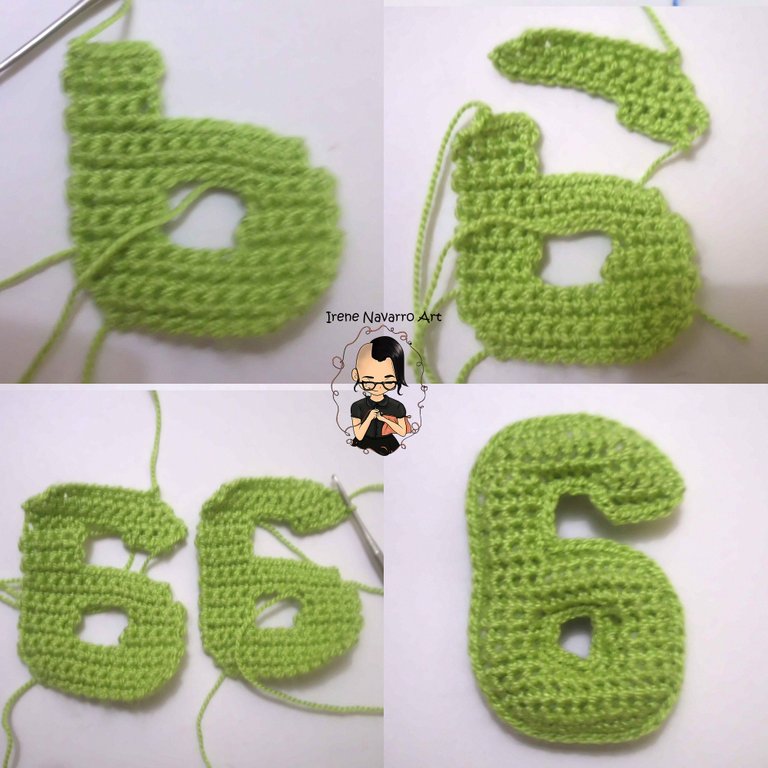

Número 7 / Number 7

Leer el gráfico de arriba hacia abajo. Tejer 11 cadenas y tejer sobre estas 11 putos bajos por cinco rondas. Tejer solo 4 puntos bajos por dos rondas.
Tejer 1 disminución, 1 punto bajo y 1 aumento y tejer 4 puntos en la ronda siguiente hasta llegar a la ronda 19. Hacer otro número igual y unir al primero tejiendo puntos bajos por todo alrededor, rellenando de fibra antes de cerrar.
Read the graph from top to bottom. Weave 11 chains and weave over these 11 low points for five rounds. Work only 4 single crochets for two rounds.
Work 1 decrease, 1 single crochet and 1 increase and knit 4 stitches in the next round until you reach round 19. Make another equal number and join the first one by knitting single crochets all around, filling in with fiber before closing.
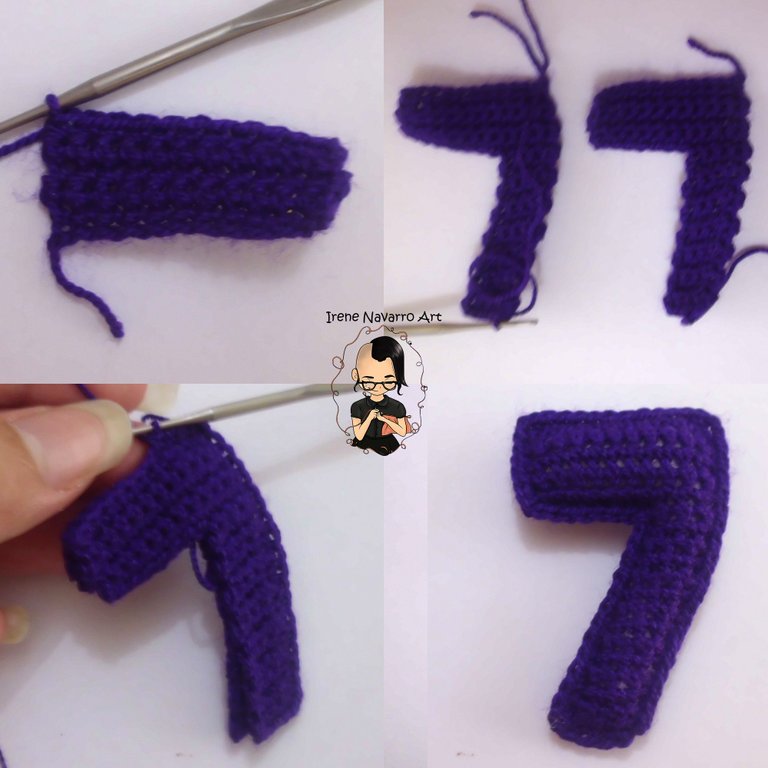

Número 8 / Number 8
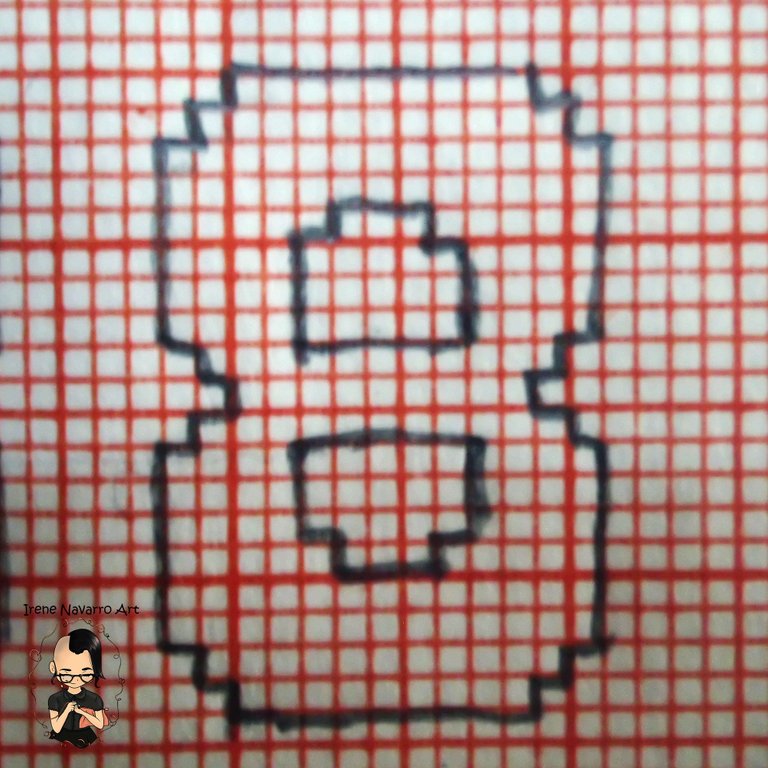
Leer el gráfico de abajo hacia arriba, tejer 9 cadenas para iniciar y tejer 9 puntos bajos sobre estas, hacer aumentos a cada lado por dos rondas hasta obtener 13 puntadas, tejer una ronda sin aumentos, en la siguiente tejer solo 5 puntos bajos y regresar para tejer 1 disminución y 3 puntos bajos. Tejer dos rondas sin aumentos.
Levantar 5 puntos bajos en el otro extremo, en la siguiente ronda tejer 3 puntos bajos y una diminución, tejer dos rondas sin aumentos, tejer 5 cadenas adicionales y tejer 4 puntos bajos en el otro extremo para unirlos. Tejer 1 Disminución, 9 puntos bajos, 1 disminución. Tejer 1 disminución, 7 puntos bajos, 1 disminución. Tejer 1 aumento, 7 puntos bajos, 1 aumento. Tejer un aumento y 2 puntos bajos. Tejer 4 puntos bajos por dos rondas.
Levantar los puntos al otro extremo y tejer 2 puntos bajos y 1 aumento. Tejer 4 puntos bajos por dos rondas. Tejer 3 puntos bajos y 1 aumento, tejer 3 cadenas adicionales y tener 1 aumento y 3 puntos bajos en el otro extremo para unirlos. Tejer 13 puntos ajos por dos rondas. Tejer 1 Disminución, 9 puntos bajos, 1 disminución. Tejer 1 disminución, 7 puntos bajos, 1 disminución. Hacer otro número igual y unir al primero tejiendo puntos bajos por todo alrededor, rellenando de fibra antes de cerrar.
Read the graph from bottom to top, knit 9 chains to start and knit 9 single crochets over them, make increases on each side for two rounds until you get 13 stitches, knit one round without increases, in the next knit only 5 single crochets and return to knit 1 decrease and 3 single crochets. Knit two rounds without increases.
Pick up 5 single crochets at the other end, in the next round knit 3 single crochets and a diminution, knit two rounds without increases, knit 5 additional chains and knit 4 single crochets at the other end to join them. Knit 1 decrease, 9 single crochets, 1 decrease. Knit 1 decrease, 7 single crochets, 1 decrease. Work 1 increase, 7 single crochets, 1 increase. Work an increase and 2 single crochets. Work 4 single crochets for two rounds.
Pick up the stitches at the other end and knit 2 single crochets and 1 increase. Work 4 single crochets for two rounds. Work 3 single crochets and 1 increase, work 3 additional chains and have 1 increase and 3 single crochets at the other end to join. Knit 13 garlic stitches for two rounds. Knit 1 decrease, 9 single crochets, 1 decrease. Knit 1 decrease, 7 single crochets, 1 decrease. Make another equal number and join the first by knitting single crochets all around, filling with fiber before closing.
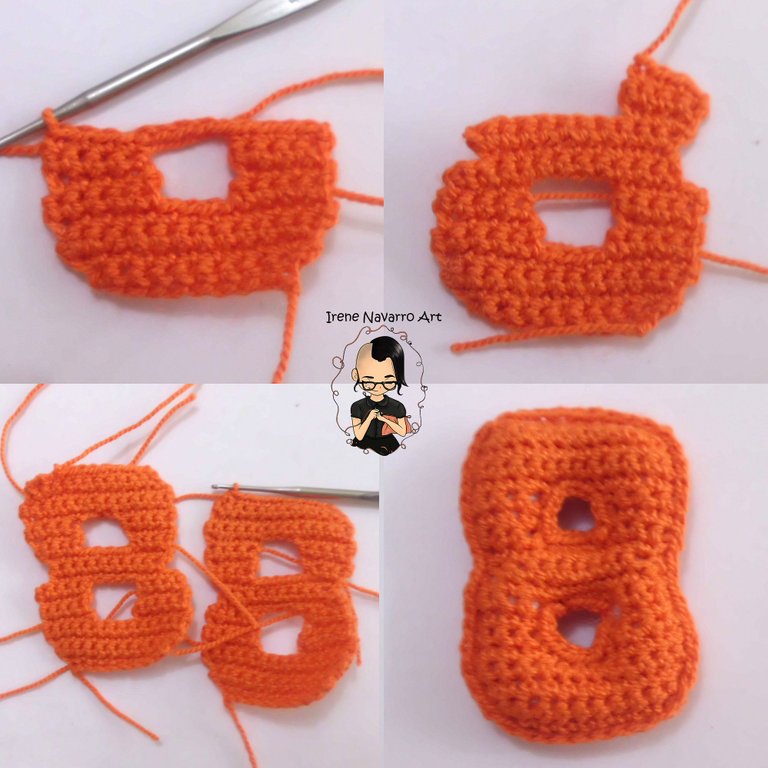

Número 9 / Number 9
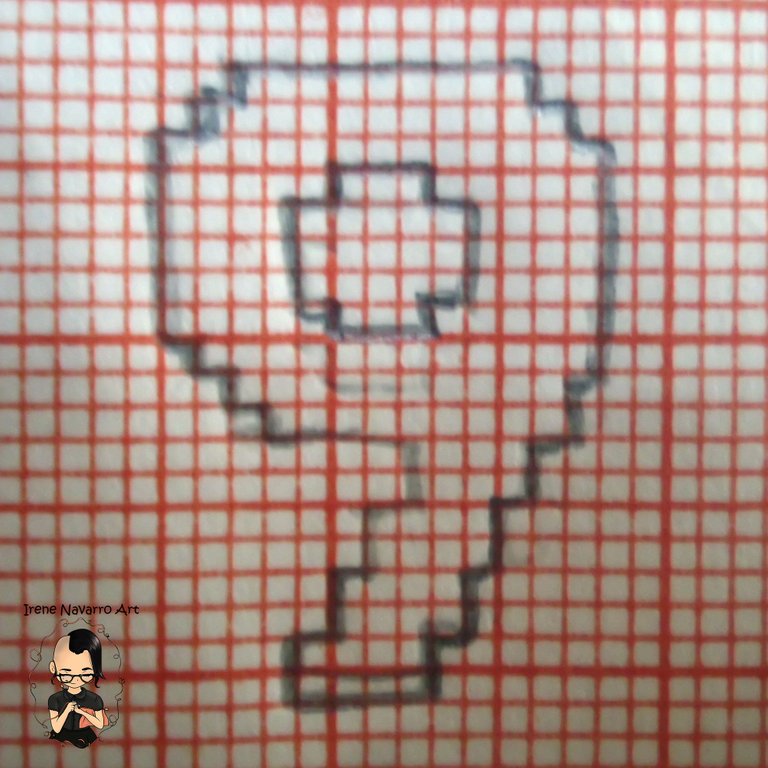
Leer el grafico de arriba hacia abajo. Tejer 9 cadenas para iniciar y tejer 9 puntos bajos sobre estas, hacer aumentos a cada lado por dos rondas hasta obtener 13 puntadas, en la siguiente tejer solo 5 puntos bajos y regresar para tejer 1 disminución y 3 puntos bajos. Tejer dos rondas sin aumentos.
Levantar 5 puntos bajos en el otro extremo, en la siguiente ronda tejer 3 puntos bajos y una diminución, tejer dos rondas sin aumentos. Tejer 3 puntos bajos y 1 aumento, tejer 3 cadenas adicionales y tener 1 aumento y 3 puntos bajos en el otro extremo para unirlos. Tejer 1 disminución y 11 puntos bajos. Tejer 1 disminución, 8 puntos bajos y 1 disminución. Tejer 1 disminución y 8 puntos bajos.
Tejer 1 disminución, 1 punto bajo y 1 aumento y tejer 4 puntos en la ronda siguiente hasta llegar a la ronda 19. Hacer otro número igual y unir al primero tejiendo puntos bajos por todo alrededor, rellenando de fibra antes de cerrar.
Read the graph from top to bottom. Knit 9 chains to start and knit 9 single crochets over these, make increases on each side for two rounds until you get 13 stitches, in the next knit only 5 single crochets and return to knit 1 decrease and 3 single crochets. Knit two rounds without increases.
Pick up 5 single crochets at the other end, in the next round knit 3 single crochets and a decrease, knit two rounds without increases. Work 3 single crochets and 1 increase, work 3 additional chains and have 1 increase and 3 single crochets at the other end to join. Work 1 decrease and 11 single crochets. Work 1 decrease, 8 single crochets and 1 decrease. Work 1 decrease and 8 single crochets.
Work 1 decrease, 1 single crochet and 1 increase and knit 4 stitches in the next round until you reach round 19. Make another equal number and join the first one by knitting single crochets all around, filling in with fiber before closing.


Número 0 / Number 0
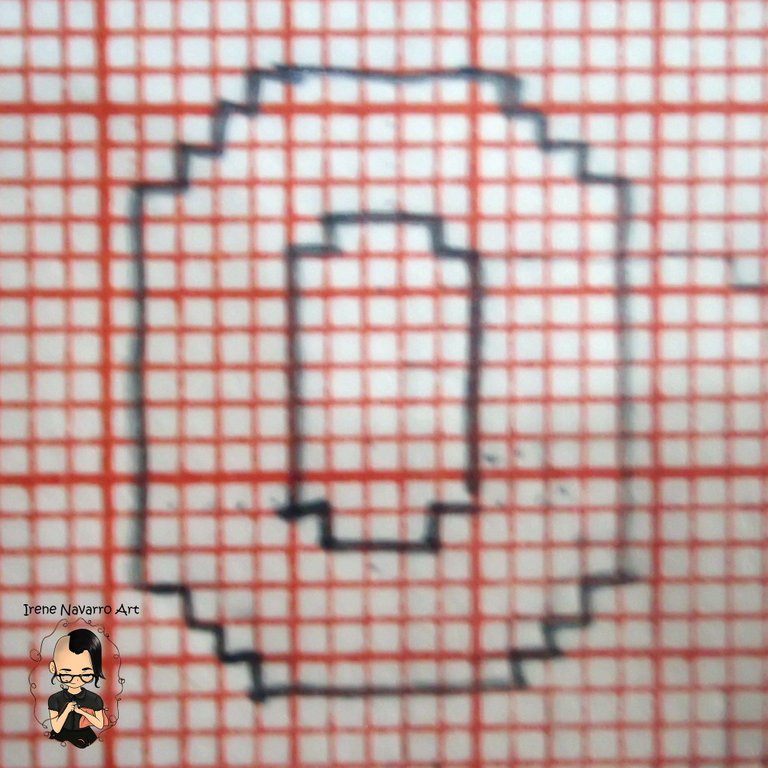
Tejer 7 cadenas y sobre estas tejer 7 puntos bajos, luego hacer aumentos al inicio y al final por tres rondas hasta obtener 13 puntadas, en la quinta ronda tejer solo 5 puntos bajos y regrese a la sexta ronda tejiendo una disminución y tres puntos bajos. Tejer rondas sin aumentos. Tejer 3 puntos bajos y 1 aumento.
Tejer la segunda parte exactamente igual a la primera. Unir las dos partes cosiendo con una aguja de ojal grande. Hacer otro número igual y unir al primero tejiendo puntos bajos por todo alrededor, rellenando de fibra antes de cerrar.
Knit 7 chains and on these knit 7 single crochets, then make increases at the beginning and at the end for three rounds until you get 13 stitches, in the fifth round knit only 5 single crochets and return to the sixth round knitting a decrease and three single crochets. Knit rounds without increases. Work 3 single crochets and 1 increase.
Knit the second part exactly the same as the first. Join the two parts by sewing with a large buttonhole needle. Make another equal number and join the first by knitting single crochets all around, filling with fiber before closing.
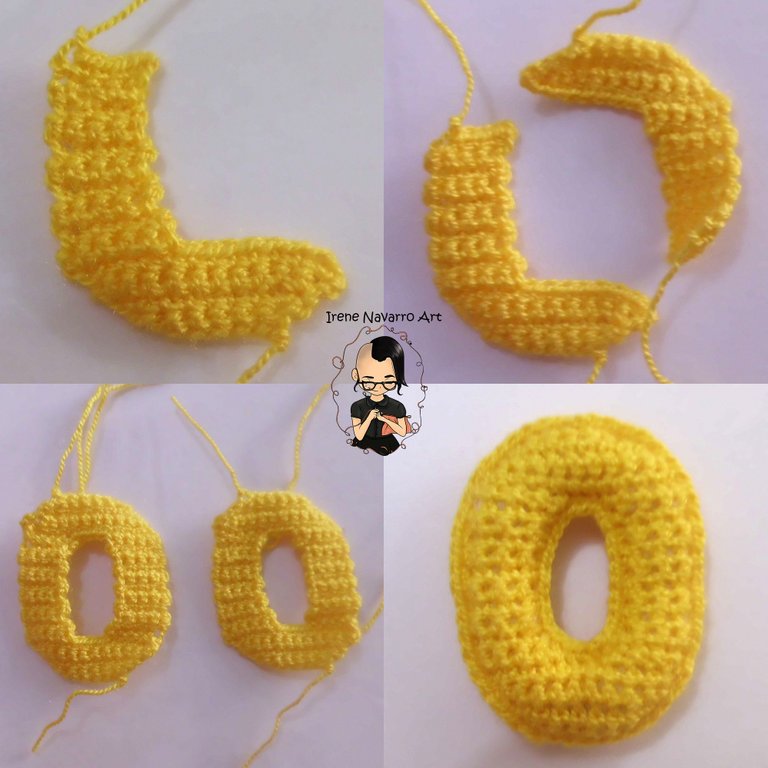

Símbolos + y – / + And - symbols
Para el símbolo – tejer 13 cadenas y tejer sobre estas 13 puntos bajos por 4 rondas. Hacer otro igual y unir al primero tejiendo puntos bajos por todo alrededor, rellenando de fibra antes de cerrar.
For the symbol - knit 13 chains and knit over these 13 single crochets for 4 rounds. Make another one the same and join the first one by knitting single crochets all around, filling with fiber before closing.
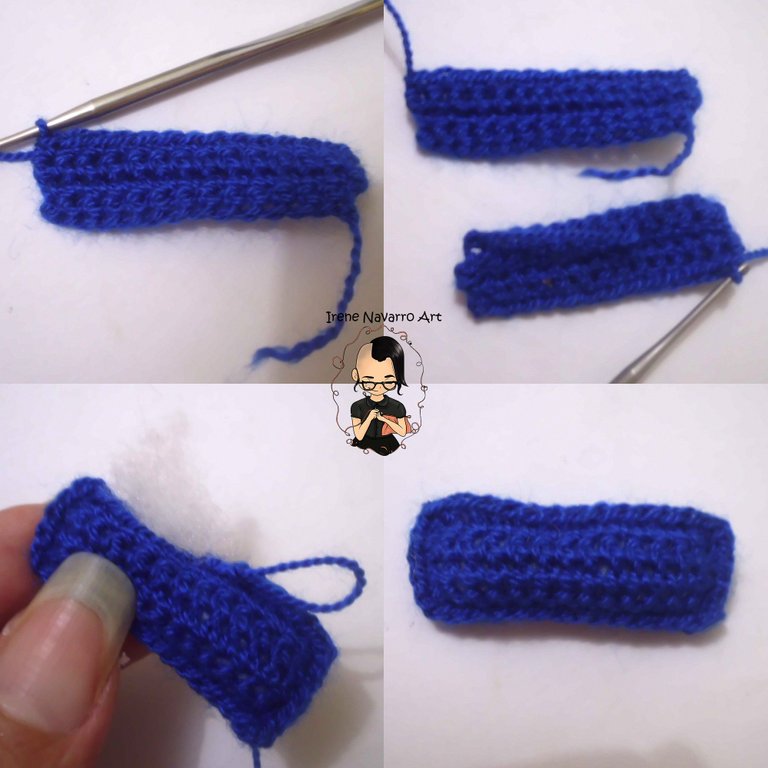
Para el símbolo + tejer 16 cadenas y tejer sobre estas 13 puntos bajos por 4 rondas. Levantar los 4 puntos centrales y tejer 6 rondas de cada lado. Hacer otro igual y unir al primero tejiendo puntos bajos por todo alrededor, rellenando de fibra antes de cerrar.
For the symbol + knit 16 chains and knit over these 13 single crochets for 4 rounds. Pick up the central 4 stitches and knit 6 rounds on each side. Make another one the same and join the first one by knitting single crochets all around, filling with fiber before closing.


Resultado / Result
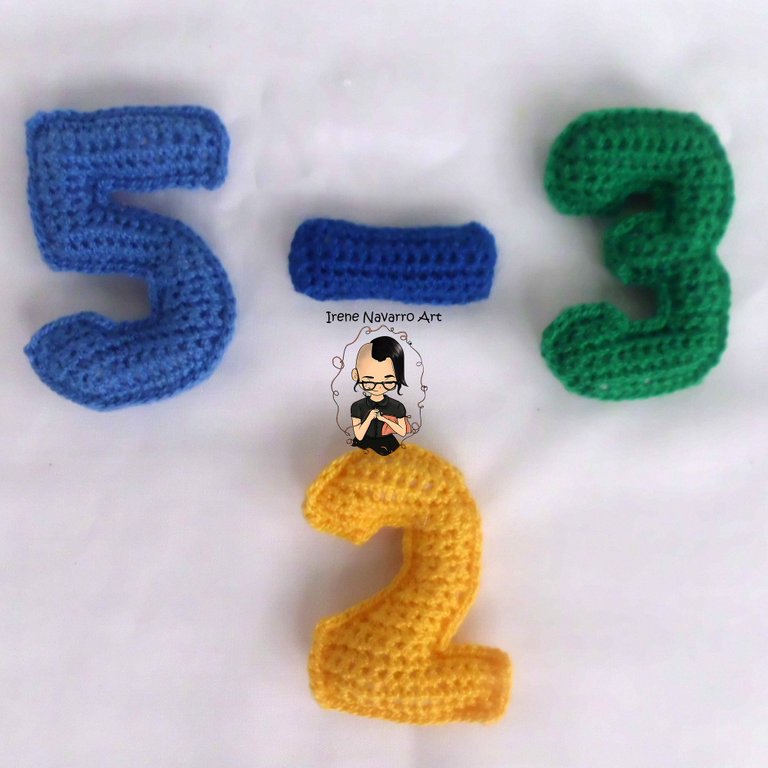
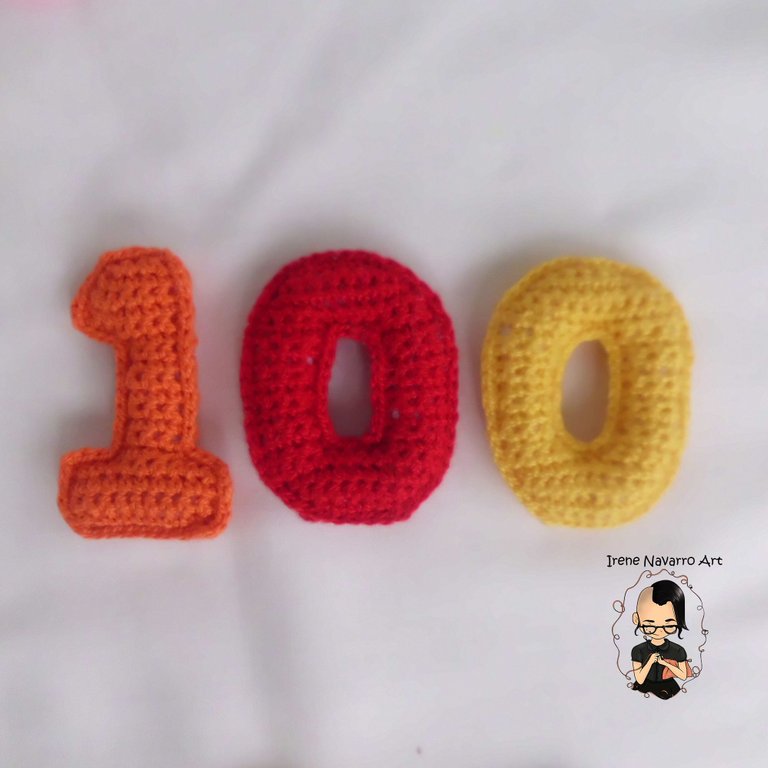

Imágenes tomadas con cámara Casio QV-R100 y editadas en Adobe Photoshop Cs6
Images taken with Casio QV-R100 camera and edited in Adobe Photoshop Cs6
Invítenme un Café/Support Me on Ko-Fi
Si te gusta mi contenido y quieres apoyarme a seguir dibujando, pintando, escribiendo y tejiendo puedes invitarme un Ko-fi en el enlace que les dejo aquí abajo, les recuerdo que es fácil, se usa Paypal y Tarjeta. ¡Muchas gracias a todos!
If you want to support my art you can also make donations for the value of a coffee (Ko-Fi) this uses Paypal, it is simple and with it I will be able to continue knitting and buying materials to create and share my publications

https://ko-fi.com/irenenavarroart
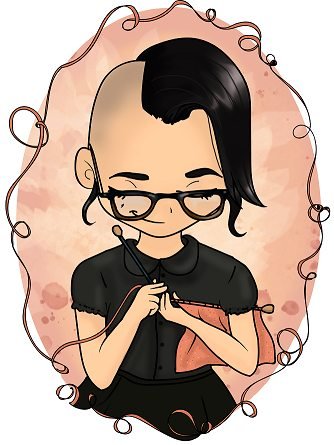
Espero les haya gustado. Les invito a leer mis próximas publicaciones y siempre estaré dispuesta a responder sus preguntas y comentarios, también pueden seguirme y contactarme en cualquiera de mis redes sociales. ¡Muchas gracias!
I hope you liked it. I invite you to read my next publications and I will always be willing to answer your questions and comments, you can also follow me and contact me on any of my social networks. Thank you!

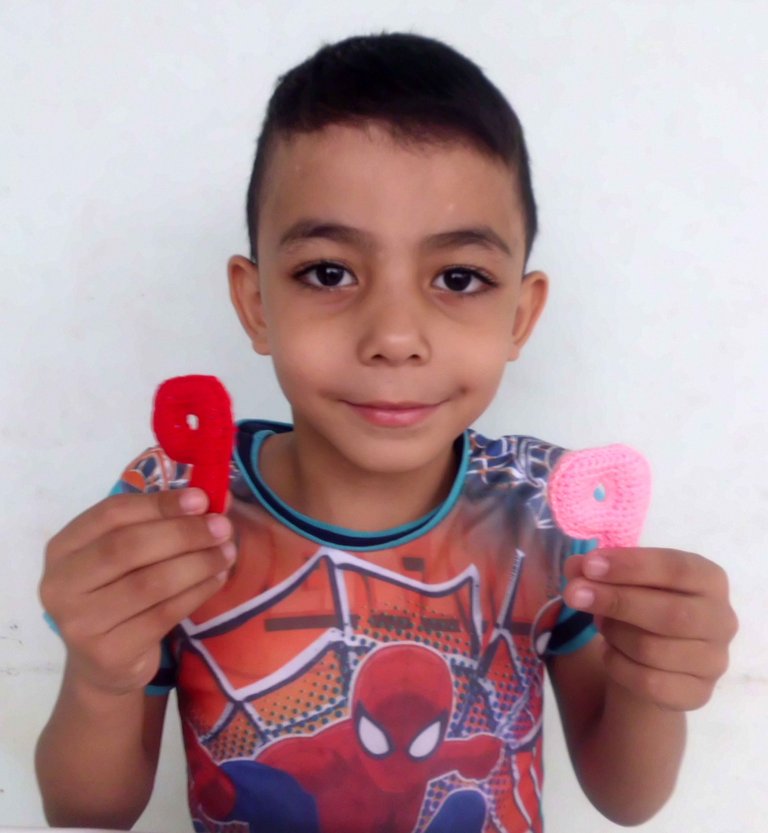
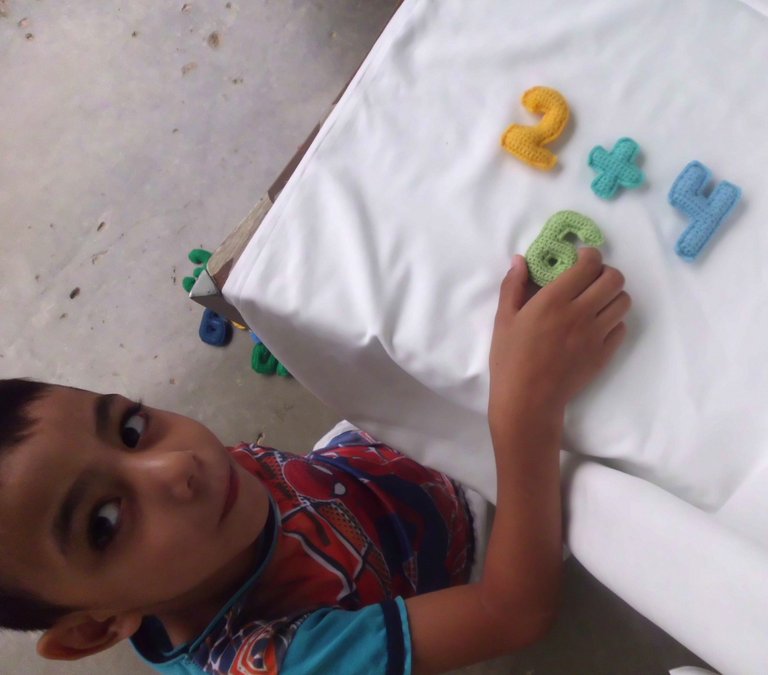
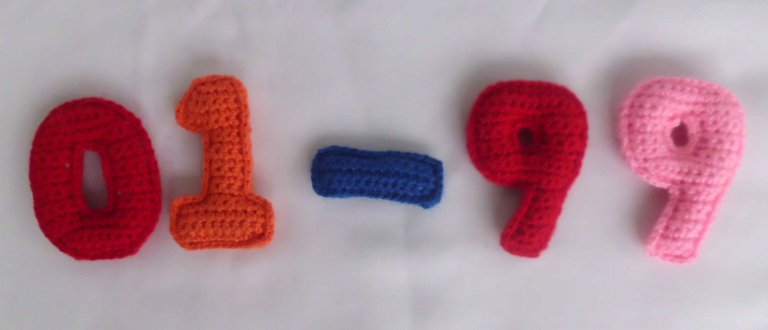
perfect numbers to help children learn. You made it so neat, cool!
Thank you very much :D
you're welcome :)
Wooaooo!! tremendo tutorial jeje.. te felicito... y muy buena idea! seguro a tu hijo le encantan... felicitaciones para él también por saber tanto!
Muchas gracias <3 en efecto le encantaron :) gracias comentar
No puedo con tanta belleza, quiero unos para Mi Mathias, con él me ha sido bastante difícil enseñarle los números, mi paciencia no da para mucho y él es de los niños pillos que le gusta hacerme enojar, y cuando toca hacer tareas con números siempre se salta los números o me los dice en el orden incorrecto, cuando esta con la maestra los cuenta a la perfección, e incluso solo a veces lo escucho contando los números en perfecto orden, siento que me trolea jajaja. ame estos juegos de números son geniales.
Muchas gracias, bueno si los niños son picaros jeje Mi Rafael es con la escritura, conmigo escribe bien bonito las letras, pero cuando hace actividades con mi mamá o mi hermana escribe feísimo, es decir, el sabe que a ellas puede engañarlas y escribir así como salga sin mirar el tamaño o forma de las letras. Pero es bueno que le hagas cositas para que se anime y lo vean como un juego, por ejemplo con mi hijo contamos hasta los besos que nos damos, como una competencia, yo le dio te voy a dar tantos besos y se los cuento y el para ganarme, hace los mismo pero con un numero mas alto y así vamos, cada tarea de la casa la contamos, desde las tazas de agua que echamos en un tobo, hasta el tiempo que duramos cepillándonos los dientes. Un abrazo querida, paciencia que todos aprenden a su ritmo <3
Gracias por el consejo bella, la verdad no habia pensado en esa idea! y es asi, todos aprenden a su ritmo y no todos desarrollan las mismas habilidades!
y valoró este comentario.
@elcomentador es un proyecto que recompensa el compromiso, curando aquellos comentarios que aporten valor a las publicaciones. Si deseas conocer más sobre nosotros y compartir tu comentario para que sea valorado, únete a nuestro servidor de Discord.
Visita la etiqueta #hivecomments y vuélvete un experto.
Muchas gracias :D
Hola, me encanta el post y la creatividad para realizar y enseñar los números a tu hijo.
Muchas gracias :D
Saludos @irenenavarroart,
Muy buena publicación, que excelente idea has compartido, y además sustentada con argumento profesional. Me has dejado sin palabras.
Los números lucen hermosos, la carita de tu hijo de contento, es la mejor retribución a tan maravilloso aporte a su formación académica.
Gracias por compartir.
Saludos
Muchas gracias, si su cara y su entusiasmo de jugar con ellos son mi recompensa <3
Que hermoso y educativo!!! Guao desde mi computador lo vi y me impacto. Creo que necesito algo así para m hija jajaja que hermoso trabajo. @irenenavarroart
Muchas gracias por comentar, si no tejes también puedes hacerle números de tela o fieltro y se los rellenas :)
Que hermoso trabajo Irene, te quedaron muy geniales todos los números, seguro con tu educacion Rafa sera un niño muy inteligente y creativo con cada juguete maravilloso que creas para el. <3 Felicidades!
Muchas gracias Yetsi <3
que buen trabajo te felicito, la verdad que debe ser excelente madre y excelente profesora, que maravilla ojala que todos los niños tuvieran la dicha de tener madres de tu estilo, la formación de nuestros hijos son semilla de esperanza para el futuro de los pueblos...que tu posts llegue a muchas muchas madres para que agarren ideas como esta y supongo que otras mas...para ayudar a sus hijos en el aprendizaje. mil bendiciones para ti y para tu hijo.
Muchas gracias @mariitaestherz el estar tanto en casa por la pandemia ha sido duro sobre todo para distribuir el tiempo, ahora muchos padres sufren por no tener suficiente horas para dedicarle a enseñar a los mas pequeños que están sin escuela, pero hay que ir haciendo pequeñas cosas, cambios en la casa incluso para que tanto encierro no los abrume y les impida a aprender. Un abrazo!
This is amazing! I remember the alphabet amigurumi I made 2 years ago for my daughter. She did learn the alphabet quicker because of that. Now that she's turning 5 too, I may also have to make number amis too.
Your little boy must be really happy with his new numbers amigurumi set.
Yet another beautiful project! 😍
Thank you, yeah the alphabet amigurumi is a very good project too, i'm glad you girl learn the alphabet quicker :D
Excelente propuesta, tienes mucha razón, no todos tenemos la misma manera de aprender, y detectarlo permite encontrar la mejor dinámica para enseñar, sobre todo a los más pequeños 🤗
Muchas gracias, es cierto, los adultos podemos hacer hasta test para identificar nuestro estilos pero con los niños se debe observar mucho y prestar atención a todas las pequeñas señales :)
Awesome
Thank you :)
Excelente tutorial amiga te felicito, tienes mucho talento en una oportunidad teji un sweter con 2 agujas y tarde mucho en elaborarlo requiere de dedicación amor y energía , tu tienes todo eso te aradezco tu detallada explicación.
Muchas gracias, si tejes a dos agujas el mismo gráfico te sirve para hacer los números, solo tendrías que unir ambas partes por una costura o con un ganchillo :)
Que precioso quedo.....me encanta esa idea...es creativo y educativo...uffff te la comiste!
Me alegra que te guste, gracias :D
De verdad que se requiere de muchísima paciencia para ejecutar todo este trabajo. Felicitaciones, además del sentido que le das a la historia todo lo demás es también impecable. Saludos y mucho éxito.
Muchas gracias, bueno si es un trabajo de paciencia, yo subestimé el tiempo, pensé que por ser números no me tadaría tanto, pero me llevó 5 días para completar los 20 mas los símbolos, creo que hasta con mi experiencia no supe hacer el calculo, pero estoy muy feliz de que resultaran bien :)
Dios bendiga tu creatividad! Buen ejemplo para las madres de la comunidad, una forma de conseguir la atención de los niños y se divientan mientras aprenden los números que muchas veces parecen complicados ! los números son las claves para el éxito!
Muchas gracias <3 que bonita frase
que bello!!! espero algún día poder tejer algo decente, trate de hacerle un gorrito de elfo a mi gato y me salió algo parecido a un revolver ja ja que increíble tu trabajo!! :)
Jajajaja tranquila con paciencia todo se puede, cuando era niña mis primeros tejidos los hice muy mal, pero ahora hay muchas oportunidades con interent puedes aprender de todo :)